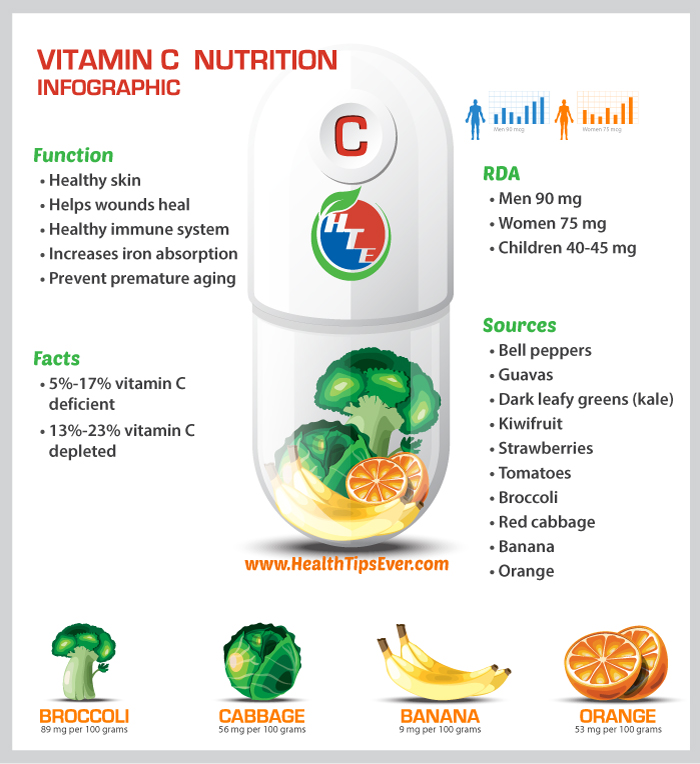Vitamin C Infographic – Recommended Daily Allowance?
Vitamin C is a water soluble vitamin that is also known as ascorbic acid. This nutrient is needed by the body to make collagen which is a vital component for healthy skin, muscles, tendons, ligaments and blood vessels. It is also crucial for wound healing.
Vitamin C also strengthens the immune system and helps the body fight infections. As a powerful antioxidant, it protects cells from the damage caused by free radicals which results in chronic diseases and premature aging. This nutrient also helps the body absorb more iron from the diet.
Foods that are good sources of vitamin C include:
- Bell peppers
- Guavas
- Kale and other dark green leafy vegetables like spinach
- Kiwifruit
- Strawberries and other berries like blueberries
- Tomatoes
- Broccoli
- Red cabbage
- Bananas
- Oranges and other citrus fruits like grapefruit
Other fruits which are rich in this nutrient include cantaloupe melons, watermelons, mangos, papaya and pineapples.
Brussels sprouts, cauliflower, winter squash and sweet potatoes are other vegetables which are good sources of vitamin C.
Herbs and spices like coriander, thyme, cloves, saffron, basil, rosemaryand cayenne pepper are also great sources of this antioxidant.
Foods that have been fortified with vitamin C are other good sources of this nutrient. Examples include fruit juices and cereals.
Recommended Dietary Allowance of Vitamin C
The recommended dietary allowance (RDA) for vitamin C is 90 mg per day for men and 75 mg for women.
This RDA for vitamin C can be obtained by eating 100 grams of broccoli which is around 1 cup. 100 grams of red cabbage provides 56 mg of vitamin C while 100 grams of oranges contains 53 mg of vitamin C. 100 grams of bananas contains 9 mg of vitamin C.
Pregnant women need 85 mg of vitamin C per day and those who are breastfeeding 120 mg each day.
Smokers and those who live and work with them and inhale secondhand smoke need an additional 35 mg of vitamin C each day.
The RDA for children is as follows:
- 0-6 months 40 mg
- 7-12 months 50 mg
- 1-3 years 15 mg
- 4-8 years 25 mg
- 9-13 years 45 mg
Vitamin C Deficiency
A study found that in the United States, the rates of vitamin C deficiency ranged from 5%-17% while those of vitamin C depletion were 13%-23%.
Vitamin C deficiency causes scurvy which is characterized by fatigue, bleeding gums and loss of teeth. Depression has also been linked to scurvy. Other symptoms of vitamin C deficiency include easy bruising, nose bleeding, bleeding from the skin, slow wound healing and swollen joints which are also painful. Theskin also tends to be dry, rough and scaly in persons lacking this nutrient. This is often associated with corkscrew hairs which split and are dry. Anemia also develops in persons who are deficient of this vitamin.
Conclusion
Vitamin C is required by the body to make healthy skin, muscles and tendons and maintain a healthy immune system. Foods that are good sources of this vital vitamin should therefore be consumed every day to prevent vitamin C deficiency.

